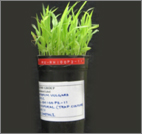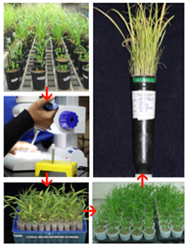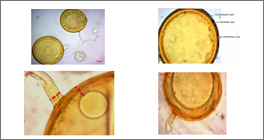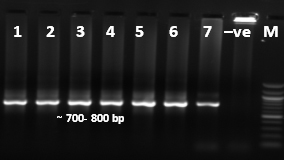Services
Deposit and Safeguarding Services
Donors can deposit cultures and receive accession codes for their cultures. The bank can assist by growing and safeguarding these cultures for individuals who are unable to do the same due to lack of knowledge or lack of facilities.
Purification Services
For individuals who are interested in analysing and characterizing the diversity that exists in their deposit, the bank has the expertise to purify their culture.
Monosporal of AMF: Soil samples of the individual are commenced and maintained as trap cultures to enhance the AMF spore population using different bait plants. Once these reference cultures are established and show good health, the spores are screened. The screening is done on the basis of morphotaxonomy and scrutinization of the diversity is done with the purpose of generating pure cultures (Monosporal).
Monosporal are initiated by attempting a symbiotic relationship between single spore of AMF with single pre-germinated seed of sorghum vulgar placed in a micropipette tip. A routine check to evaluate the spore count and colonization status is done on monthly intervals. Once the monosporal culture shows high sporulation and colonization, it is designated as a successful culture.
Pure cultures of ectomycorrhiza : Sporocarp or fruiting bodies of Ectomycorrhiza are collected or received from the depositor. A small portion of the sporocarp is surface sterilized and then placed on a suitable medium for its growth and proliferation. Once the mycelial growth establishes itself, it is constantly subcultured and purification is done subsequently, till a pure culture is achieved.
Substantiation Services
Identification of Mycorrhizal Reference Material: The bank nurtures the expertise of identifying the mycorrhizal diversity using different conventional and modern tools as follows:
Morphotaxonomic Characterization: For Arbuscular Mycorrhizal fungi, conventional methods are adopted that include preparing voucher specimen using Polyviny lactoglecerol (PVLG) and Melzer Reagent. Microscopic studies of spore characters like wall layers, colour reaction with Melzer Reagent, mycelia attachment, presence or absence of septum, etc. are recorded.
For ECM, morphotype analysis of the hyphal sheath is done since they differ in appearance. The hyphal sheath can vary in colour, branching, shape of the hyphae in the soil, appearance of the rhizomorph, and the structure of the inner surface.
Molecular Characterization: Molecular characterization is one of the most promising tools for authentication of both ecto and endomycorrhiza. The DNA extraction of the pure cultures is carried out using total DNA extraction methods. PCR amplification of partial sequences of rDNA, which include partial sequence of SSU, complete sequence of ITS1, 5.8 S rDNA, ITS2, and partial sequence of LSU is done using gene specific primers. Similarly, PCR amplification of partial sequence of the mitochondrial LSU (mtLSU) rDNA is done using gene specific primers. These partial sequences are cloned, sequenced, and analysed with the large sets of sequences available in the database and its phylogenetic analysis is carried out to characterize and identify the culture identity.
Biochemical Characterization: Fatty acids methyl esters (FAME) profiles using lipids present in the spore of AMF of individual isolates collected from different regions are generated using Gas Liquid Chromatography. The abundance of lipids in spores and vesicles of AMF colonized roots in case of AMF is a potentially useful biochemical character for taxonomic purposes and quantification of glomalean fungi. The bank, with the wide diversity that it is preserving, has created an extensive fatty acid profile library, which has helped in understanding the biochemical biodiversity that exists among the different mycorrhiza collected from different regions. The quantitative and qualitative differences in the fatty acid composition in the spores among different isolates can be done by generating fatty acid methyl esters (FAME) profiles using gas-liquid chromatography.







